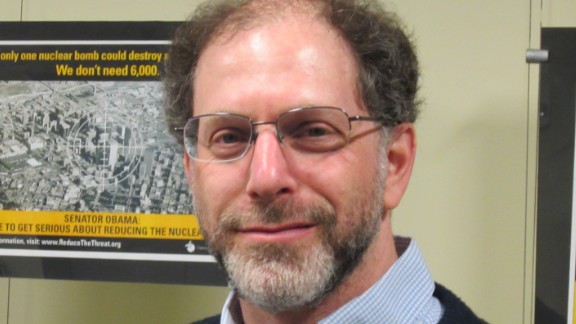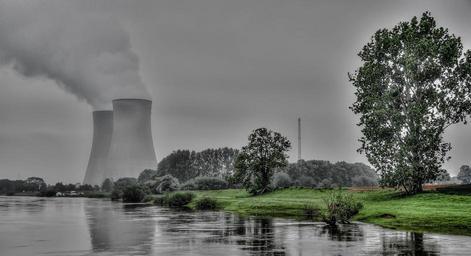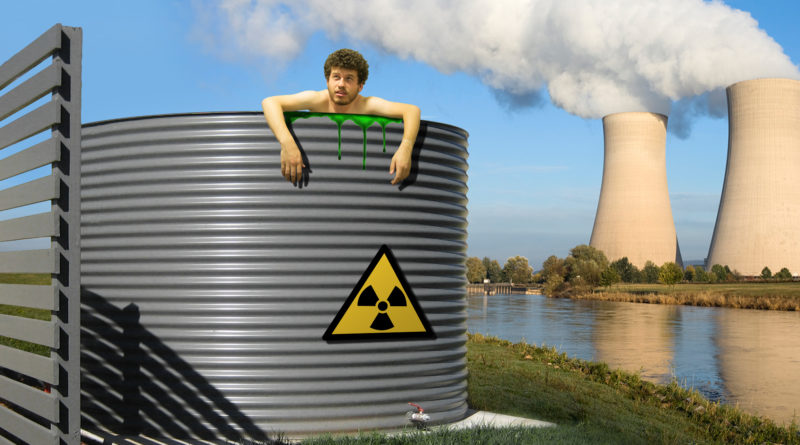
The NRC wants to gut safety measures
to build untested nuclear reactors
— maybe in your neighborhood
Karl Grossman / CounterPunch & The Progressive
(December 6, 2022) — “Guinea Pig Nation: How the NRC’s new licensing rules could turn communities into test beds for risky, experimental nuclear plants,” is what physicist Edwin Lyman, director of nuclear power safety with the Union of Concerned Scientists, titled his presentation on November 17.
The “Night with the Experts” online session, organized by the Nuclear Energy Information Service, focused on how the US Nuclear Regulatory Commission (NRC) is involved in a major change of its rules and guidance to gut government regulations to pave the way for what the nuclear industry calls “advanced” nuclear power plants.
Already, Lyman said, the NRC has moved to allow the construction of nuclear power plants in thickly populated areas. This “change in policy” was approved in a vote by NRC commissioners in late July.
For more than a half-century, the NRC and its predecessor agency, the US Atomic Energy Commission, sought to have nuclear power plants built in “low population zones”—because of the threat of a major nuclear plant accident. But this year the NRC substantially altered this policy.
The lone NRC vote against the change came from Commissioner Jeff Baran, who in casting his ‘no’ vote wrote:
“Multiple, independent layers of protection against potential radiological exposure are necessary because we do not have perfect knowledge of new reactor technologies and their unique potential accident scenarios . . . . Unlike light-water reactors, new advanced reactor designs do not have decades of operating experience; in many cases, the new designs have never been built or operated before.”
He cited the NRC criteria, which declare that the agency “has a longstanding policy of siting nuclear reactors away from densely populated centers and preferring areas of low population density.” Under the new policy, he noted, a “reactor could be sited within a town of 25,000 people and right next to a large city.”
That is just one of the many reductions proposed in safety standards.
“The central issue,” says Lyman in an interview following his presentation, “is that the NRC is accepting on faith that these new reactors are going to be safer and wants to adjust its regulations accordingly, to make them less stringent—on faith.”

Edwin Lyman, Union of Concerned Scientists
The industry’s new line of smaller nuclear power plants—including what it calls the “small modular nuclear reactor”—are much more expensive than existing light-water nuclear power plants. The older, more common nuclear power plants are large and cooled by plain water, whereas the new “advanced” plants are more costly, in part because they are cooled by various other substances.
Weakening safety standards will, of course, make it easier to build and cheaper to operate these pricey reactors. The proposed changes are a demonstration of one of the NRC’s nicknames—the “Nuclear Rubberstamp Commission.”
A list of the NRC’s proposed safety reductions was included in Lyman’s presentation, quoted here with my commentary:
- Allowing nuclear power plants to have a “small containment — or no physical containment at all.” Containments are the domes over nuclear plants to try to contain radioactive releases in an accident.
- “No offsite emergency planning requirements.” The NRC has been requiring emergency planning including the designation of a ten-mile evacuation zone around a nuclear power plant.
- “Fewer or even zero operators.” The nuclear industry would like advanced nuclear plants to operate “autonomously.”
- Letting the plants have “fewer” NRC “inspections and weaker enforcement.”
- Reduced equipment reliability reporting.
- “Applications” for an advanced reactor “should contain minimal information.”
- The NRC’s review standards should be lenient.
- Letting the plants have “fewer inspections and weaker enforcement.”
- Fewer back-up safety systems.
- Regulatory requirements should be few in number and vague.
- “Zero” armed security personnel to try to protect an advanced nuclear power plant from terrorists.
The “NRC is willing to twist and contort even reasonable safety regulations in ways that cater to nuclear industry desires to a degree that would rival a toy balloon-dog at a children’s party,” Nuclear Energy Information Service director David Kraft tells The Progressive. “It is this kind of almost institutionalized acquiescence to industry wants that has led many to believe that NRC stands for Not Really Concerned.”
In his talk, Lyman referenced a 140-page report for the Union of Concerned Scientists which he authored, issued in March 2021, titled “ ‘Advanced’ Isn’t Always Better, Assessing the Safety, Security, and Environmental Impacts of Non-Light-Water Nuclear Reactors.”
The report states: “Almost all nuclear power reactors operating and under construction today are LWRs, so called because they use ordinary water to cool their hot, highly radioactive cores.
Some observers believe that the LWR [light-water reactor], the industry workhorse, has inherent flaws that are inhibiting nuclear power’s growth,” he writes:
“In response, the US Department of Energy’s national laboratories, universities, and numerous private vendors — from large established companies to small startups — are pursuing the development of reactors that differ fundamentally from LWRs. These non-light-water reactors (NLWRs) are cooled not by water, but by other substances, such as liquid sodium, helium gas, or even molten salts.”
Though these are called “advanced” reactors, the report continues, most of them are modeled on decades-old designs.
“In part,” he notes, “the nuclear industry’s push to commercialize NLWRs is driven by its desire to show the public and policymakers that there is a high-tech alternative to the static, LWR-dominated status quo: a new generation of ‘advanced’ reactors.
But a fundamental question remains: Is different actually better? The short answer is no. Nearly all of the NLWRs currently on the drawing board fail to provide significant enough improvements over LWRs to justify their considerable risks.”
“Make no mistake about it — while NRC is doing its part to serve nuclear industry needs, we should not lose sight of the fact that it is the aggressive pro-nuclear agenda of the Biden Administration that has unleashed a juggernaut of financial and PR support for new nuclear reactors,” Kraft says:
“Everything from the tens of billions of dollars allocated for new nuclear in the Infrastructure Act and the IRA [Inflation Reduction Act, which establishes a nuclear power production tax credit], to the national dog-and-pony show [the recent US tour promoting nuclear power] of Energy Secretary Jennifer Granholm, demonstrates the Administration’s intentions to run roughshod over the objections of the public. We have a hard fight ahead of us.”
The NRC is not currently accepting comments on its plan for changes to its regulations for “advanced” reactors, according to Lyman. But he encouraged the public to weigh in on NRC actions via public meetings and email. The Nuclear Energy Information service plans to post his talk on its website.

New Nukes or No Nukes?
Karl Grossman / Special to Environmentalists Against War
NEW YORK — Suffolk County is nuclear-free — none of the seven to 11 nuclear power plants proposed for the county became a reality — after decades of intense grassroots and governmental opposition.
A key element was Suffolk County and New York State determining, after an extensive study, that a successful evacuation would be impossible in the event of a major nuclear power plant accident at the first nuclear plant built here, at Shoreham.
Thus, Suffolk County and state governments refused to draw up and agree to implement a federally required evacuation plan. The Shoreham plant was scuttled.
But now the US Nuclear Regulatory Commission is in the midst of radically altering its regulations for the new line of nuclear power plants that the nuclear industry is seeking to develop, what it calls “advanced” nuclear power plants.

“Guinea Pig Nation”
Two weeks ago, Dr. Edwin Lyman, director of Nuclear Power Safety with the Union of Concerned Scientists, gave a presentation he titled “Guinea Pig Nation: How the NRC’s new licensing rules could turn communities into test beds for risky, experimental nuclear plants.”
The information he presented has received no major media coverage, which is par for the nuclear course. This is why I named my first book on nuclear power “Cover Up: What You Are Not Supposed To Know About Nuclear Power.”
Lyman, who has a doctorate in physics, knows nuclear technology intimately. He joined the Union of Concerned Scientists in 2003. Previously, he was president of the Nuclear Control Institute. He was a postdoctoral research associate at Princeton’s Center for Energy and Environmental Studies. He co-authored the book “Fukushima: The Story of a Nuclear Disaster.”
He explains that the nuclear industry wants nuclear safety standards significantly weakened, because the “advanced” nuclear plants are “much more expensive” than existing plants. And they would be more costly to operate than using energy alternatives, “certainly wind and solar.”
So, the NRC is “accepting on faith” the industry claim that the “advanced” nuclear power plants are “going to be safer and wants to adjust its regulations accordingly, to make them less stringent.”
It’s a demonstration of one of the alternatives that’s been applied as the acronym for the NRC: Nuclear Rubberstamp Commission.
Already, in a decision in July, the NRC moved to allow nuclear power plants to be built in thickly populated areas. For a half century, the NRC sought to have the plants sited in areas of “low population density,” because of the catastrophic accident threat.

Nuclear powerplants in Ukraine.
New NRC Rules Would allow Reactors in Cities
The lone NRC vote against the change came from Commissioner Jeffery Baran, who declared: “Multiple, independent layers of protection against potential radiological exposure are necessary because we do not have perfect knowledge of new reactor technologies and their unique potential accident scenarios.”
Under the new policy, noted Baran, a “reactor could be sited within a town of 25,000 people and right next to a large city. For reactor designs that have not been deployed before and do not have operating experience, that approach may be insufficiently protective of public health and safety.”
That is just one of the many reductions proposed in safety standards. The list of them in Lyman’s presentation before the Chicago-based Nuclear Energy Information Service, under the categories of “Cutting corners on safety and security to cut costs” and “What the nuclear industry wants” included, in addition to the already altered siting criteria:
• Allowing nuclear power plants to have a “small containment, or no physical containment at all.”
• “No offsite emergency planning requirements.”
• “Fewer or even zero operators.”
• Letting the plants have “fewer inspections and weaker enforcement.”
• “Fewer back-up safety systems.”
• “Zero” armed security personnel to try to protect an advanced nuclear power plant from terrorists.
Lyman commented: “I could go on and on.”
His PowerPoint included a slide saying that the “NRC is not currently” accepting comments on its plan for changes in its regulations for “advanced” reactors. But, it said, “the public is always free to weigh in” on NRC actions and recommended that people attend any public meetings held on the issue.
Does this mean that in the future there might be a resurfaced push for nuclear power in Suffolk County?
Karl Grossman, professor of journalism at State University of New York/College at Old Westbury, and is the author of the book, The Wrong Stuff: The Space’s Program’s Nuclear Threat to Our Planet, and the Beyond Nuclear handbook, The US Space Force and the dangers of nuclear power and nuclear war in space. Grossman is an associate of the media watch group Fairness and Accuracy in Reporting (FAIR). He is also a contributor to Hopeless: Barack Obama and the Politics of Illusion.
Posted in accordance with Title 17, Section 107, US Code, for noncommercial, educational purposes.
